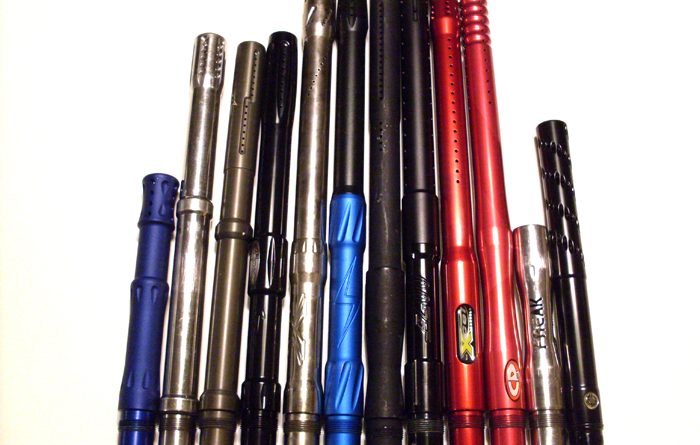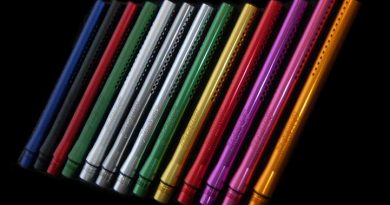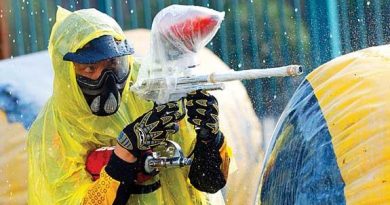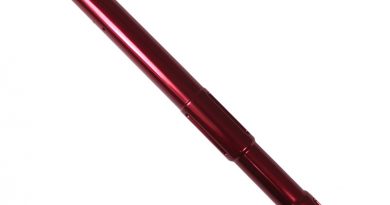All barrels tested
Lapco, Smart Parts, Bob Long, and Dye. Great barrels right? But how do they shoot? We put these barrels through a series of tests and learned a lot in this yearlong process. This was perhaps the most comprehensive paintball barrel test we have ever conducted. It has taken quite a while to compile all the scores and conduct all the tests.
Firstly, we originally had all sorts of aspirations, concepts, and ideas about how this test would work. A lot of our preconceived notions were shattered, to say the least.
The Plan:
We wanted to test the barrels on a single marker, with controlled pressure and temperature. That’s wasn’t too difficult. But finding a span of days where the outdoor temperature and air pressure was exactly the same was difficult. Here in Toledo, one day you have a blizzard, the next day you go to the beach. It’s crazy. We chose an ideal temperature of 79 degrees. We figured that is a good average; not too cold, and not overwhelmingly hot.
Originally we had wanted to test every barrel with every type of popular paintball or size. Unfortunately, much of our original plan did not work. Why? Some barrels just wouldn’t shoot certain types of paint very well. So we ended up dividing the barrels into classes and types based on bore and size. We did not want tainted results and wanted to give our reader a fair depiction of how these barrels performed.
Another thing we wanted to do was calculate standard deviations for the results, however, after compiling the raw data, the standard deviations were so large, that they were rendered statistically negligible.
The Barrels:
The barrels we tested were a Bob Long aluminum 14 inch barrel, an aluminum Dye 12 inch, a Smart Parts 14 inch stainless steel, and a Lapco 12 stainless steel. The Bob Long and Smart Parts had spiraled porting that started half way down the barrels length, while Dye had straight porting that started halfway down the barrel. The Lapco had a group of ports at the end.
Our first thoughts:
Firstly, some barrels were pretty heavy, especially the stainless steel ones, with the Lapco weighing in at about a full pound. The rest were not very problematic. Some were exceedingly long, the Bob Long, but we decided to wait and see.
Classes:
The Smart Parts and Dye shot medium to larger paints very well. We used a mixture of 2-3 different types of paints to get a good cross section. The brand names will not be disclosed, however, they ranged in price from medium price ranges to more expensive. We did not use the cheaper brands.
The Bob Long and Lapco worked well with smaller and medium sized paints, but especially well with smaller paints. We opted for a mixture of small/medium to get an even cross section. We used medium to more expensive paints.
General:
One lesson we learned is that not all barrels shoot all paints evenly. Huh? Seems like restating the obvious, but not all paints are created equal, in fact, they are created very unequally.
Hence our first postulum: Not all paints are created, even slightly, equal.
We have found that if you use a properly sized paint with your barrel you will usually get better results. Obviously.
The Marker:
We used an Autococker on a bench clamp with regulated pressure. We adjusted the marker to be shooting at 286 to 288 feet per second. We found that velocity to give the most accurate placement of paintballs. Faster speeds seemed to cause the balls to curve or veer off center. For some of the barrels we adjusted this velocity until we got better consistency. So we used the optimum settings for each barrel, to rule out inaccuracies caused by non-optimized settings.
The Tests:
We compared the barrels from different distances to see how each performed. The distances we used were 20 feet, 50 feet, and 80 feet. The 80 feet was added later because one barrel really seemed to outperform the rest at farther distances, hence we felt it necessary to include this farther distance.
We tested for accuracy at each distance. And to be statistically accurate we removed two outliers for each distance for each barrel. What are outliers? In statistical terms outliers are results that are way off track i.e. the highest or lowest reading in a large sample of middle ground readings. This helps make the results more accurate. For example, a barrel shot every shot well, but one was way off, it would not be included, so as to not taint the results. We felt that there are a lot of circumstances and variables that can be evened out if two outliers are removed for each barrel at each distance. Example of variables could be; dented paintballs, pressure changes, or a wind gust. We wanted to give the barrels the benefit of the doubt and give them an opportunity to perform well.
The two barrels that shot medium to large paint were tested and compared to each other (Class Big). The two smaller to medium paint barrels were compared together (Class Small). Furthermore, a general over all comparison for all the barrels was given, but it was more subjective than objective.
General Conclusions:
We noticed that the larger paintballs traveled farther on average than the smaller ones.
Class Big:
At 20 feet both the Smart Parts and Dye performed well, but the Dye had an advantage. The Smart Parts formed a 8.5 inch diameter marking, while the Dye formed a 5.5 inch diameter of colored area on the previously white board. We had to use an outlier for Smart Parts, as one shot was way off. Dye, on the other hand, did not use an outlier. We did notice however, that the Dye shots we flying in a more predictable pattern.
At 50 feet things really changed. Both needed to use outliers. Smart Parts took two, while Dye needed only one to save face. The Smart Parts shots were not flying in coherent patterns and were curving. We had to adjust the direction the marker was fired in to get them to land on our target. After that, we did not have too many problems. The Dye shots went straighter. Dye formed a 13.5 inch diameter, while Smart Parts formed 18 inch diameter.
At 80 feet neither produced exceptional results, and both needed outliers. The Smart Parts created a 28 inch diameter, while The Dye created 25 inch diameter.
Edge: At closer distances, both performed well. However, at more moderate distances, Dye definitely did better.




